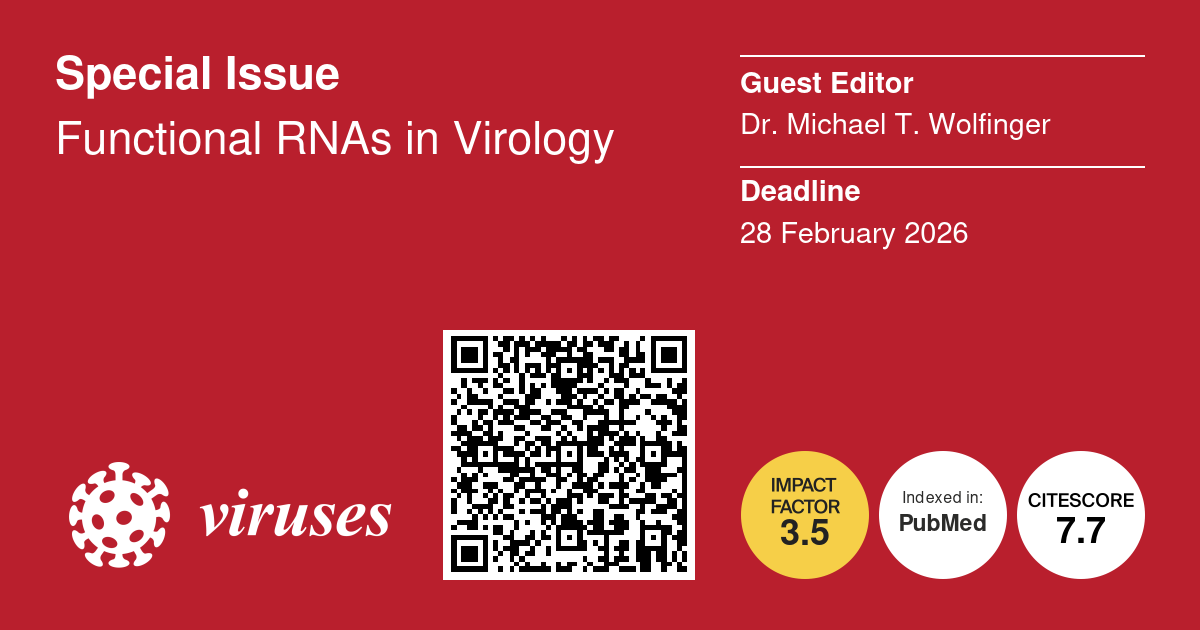Functional RNAs in Virology Special Issue
MDPI Viruses has launched a new open-access Special Issue on “Functional RNAs in Virology” to highlight recent advances in understanding how RNAs act as regulatory molecule in viral infection
I’m honored to serve as Guest Editor of the Functional RNAs in Virology Special Issue. My goal is to curate a collection of high-quality articles that explore how viral RNAs, both structured and unstructured, control translation, replication, genome packaging, immune evasion, and host adaptation.

Understanding the Role of RNA in Viruses
Far beyond acting as genetic messengers, viral RNAs have emerged as active regulators that shape virtually every step of the infection cycle. From modulating protein synthesis to regulating host interactions and genome replication, these RNAs form a molecular toolkit that viruses rely on for survival and success.
Structured elements such as IRESs, frame-shifting pseudoknots, and exoribonuclease-resistant RNAs (xrRNAs), together with unstructured sequence motifs, form an intricate regulatory network that allows viruses to thrive in diverse cellular environments. Recent discoveries, including computational predictions of highly conserved RNA elements across viral families, emphasize the evolutionary significance of RNA-based regulation.
Understanding how viruses exploit RNA structure and sequence is essential not only to decode their infection strategies but also to identify novel targets for antiviral intervention.
Scope of the Special Issue
The Functional RNAs in Virology Special Issue aims to provide a comprehensive overview of how RNA acts as a regulatory molecule in viral infection. We welcome both original research articles and reviews that explore well-characterized RNA elements as well as emerging discoveries. Topics of interest include, but are not limited to:
- 🧬 Functional RNA structures involved in translation, replication, and genome packaging
- 🔄 Long-range RNA–RNA interactions and RNA conformational switches
- 🧪 Viral non-coding RNAs
- 🔬 Exoribonuclease-resistant RNAs (xrRNAs) and RNA-driven immune evasion
- 🌐 RNA structural conservation and covariation across virus species or lineages
- 🧠 Computational discovery and modeling of functional RNA elements
- 🧲 RNA–protein interactions involving viral RNAs and host factors
- 🧫 RNA structure probing and high-throughput functional RNA screening in viruses
A Timely Focus
In recent years, experimental advances and large-scale sequencing efforts have dramatically expanded our ability to detect and characterize functional RNA elements in viral genomes. This growing body of research is reshaping our understanding of viral strategies and uncovering new opportunities for therapeutic intervention. By focusing on RNA-mediated regulation across viral families, this Special Issue bridges molecular virology, RNA biology, and computational genomics.
Join the Special Issue
This Special Issue will serve as a timely and interdisciplinary resource for researchers working on RNA-based mechanisms in viruses. If you are investigating RNA structures, RNA–protein interactions, or computational RNA analysis in virology, we encourage you to submit your work.
Details & Submission
Join the Conversation
Have questions about a potential submission or want to discuss a research idea? Don't hesitate to get in touch via the contact form or connect with me on LinkedIn.